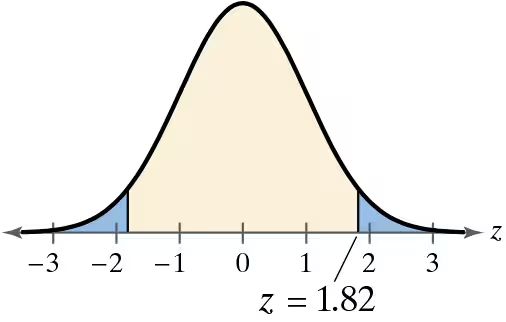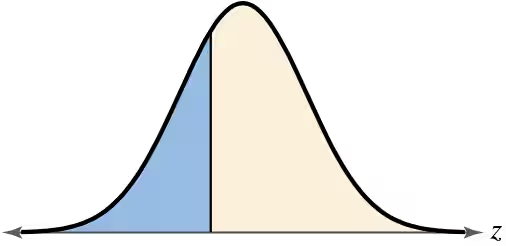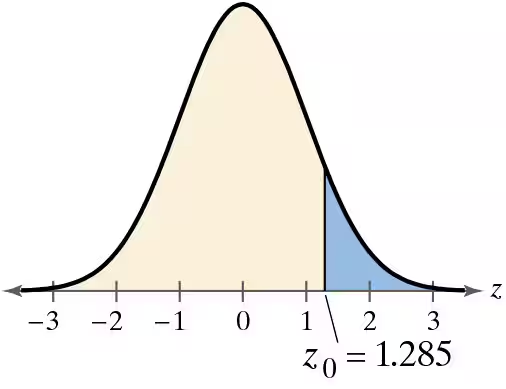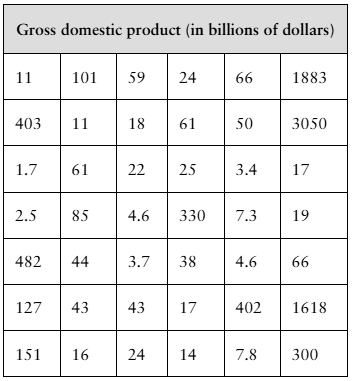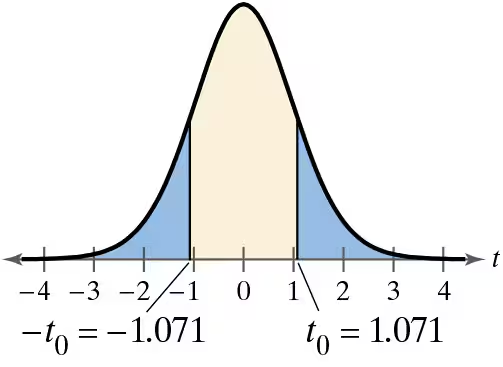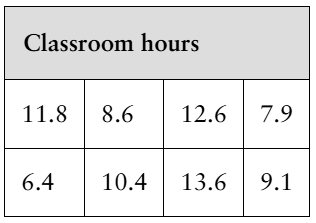 Back
BackProblem 7.2.46
Writing In a right-tailed test where P < alpha, does the standardized test statistic lie to the left or the right of the critical value? Explain your reasoning.
Problem 7.2.10
Graphical Analysis In Exercises 9–12, match the P-value or z-statistic with the graph that represents the corresponding area. Explain your reasoning.
P= 0.2802
Problem 7.2.11
Graphical Analysis In Exercises 9–12, match the P-value or z-statistic with the graph that represents the corresponding area. Explain your reasoning.
z = -2.37
Problem 7.2.12
Graphical Analysis In Exercises 9–12, match the P-value or z-statistic with the graph that represents the corresponding area. Explain your reasoning.
z = -0.51
Problem 7.2.17
Finding a P-Value In Exercises 13–18, find the P-value for the hypothesis test with the standardized test statistic z. Decide whether to reject H0 for the level of significance alpha.
Left-tailed test
z=-1.68
alpha=0.05
Problem 7.2.18
Finding a P-Value In Exercises 13–18, find the P-value for the hypothesis test with the standardized test statistic z. Decide whether to reject H0 for the level of significance alpha.
Left-tailed test
z= 1.95
alpha=0.08
Problem 7.2.24
Finding Critical Values and Rejection Regions In Exercises 23–28, find the critical value(s) and rejection region(s) for the type of z-test with level of significance α. Include a graph with your answer.
Left-tailed test, α = 0.09
Problem 7.2.28
Finding Critical Values and Rejection Regions In Exercises 23–28, find the critical value(s) and rejection region(s) for the type of z-test with level of significance α. Include a graph with your answer.
Two-tailed test, α = 0.12
Problem 7.2.31
In Exercises 29–32, test the claim about the population mean at the level of significance α. Assume the population is normally distributed.
Claim: ; μ ≠ 5880; α = 0.03; α = 413
Sample statistics: x_bar = 5771, n = 67
Problem 7.2.32
In Exercises 29–32, test the claim about the population mean at the level of significance α. Assume the population is normally distributed.
Claim: ; μ ≤ 22,500; α = 0.01; α = 1200
Sample statistics: x_bar = 23,500, n = 45
Problem 7.2.21
Graphical Analysis In Exercises 21 and 22, state whether each standardized test statistic z allows you to reject the null hypothesis. Explain your reasoning.
a. z = -1.301
b. z = 1.203
c. z = 1.280
d. z = 1.286
Problem 7.2.33
Hypothesis Testing Using a P-Value In Exercises 33–38,
a. identify the claim and state and .
b. find the standardized test statistic z.
c. find the corresponding P-value.
d. decide whether to reject or fail to reject the null hypothesis.
e. interpret the decision in the context of the original claim.
MCAT Scores A random sample of 100 medical school applicants at a university has a mean total score of 505 on the MCAT. According to a report, the mean total score for the school’s applicants is more than 503. Assume the population standard deviation is 10.6. At alpha=0.01, is there enough evidence to support the report’s claim?
Problem 7.2.34
Hypothesis Testing Using a P-Value In Exercises 33–38,
a. identify the claim and state and .
b. find the standardized test statistic z.
c. find the corresponding P-value.
d. decide whether to reject or fail to reject the null hypothesis.
e. interpret the decision in the context of the original claim.
Sprinkler Systems A manufacturer of sprinkler systems designed for fire protection claims that the average activating temperature is at least 135°F. To test this claim, you randomly select a sample of 32 systems and find the mean activation temperature to be 133°F. Assume the population standard deviation is 3.3°F. At alpha=0.10, do you have enough evidence to reject the manufacturer’s claim?
Problem 7.2.42
Hypothesis Testing Using Rejection Region(s) In Exercises 39–44, (a) identify the claim and state H0 and Ha, (b) find the critical value(s) and identify the rejection region(s), (c) find the standardized test statistic z, (d) decide whether to reject or fail to reject the null hypothesis, and (e) interpret the decision in the context of the original claim.
Light Bulbs A light bulb manufacturer guarantees that the mean life of a certain type of light bulb is at least 750 hours. A random sample of 25 light bulbs has a mean life of 745 hours. Assume the population is normally distributed and the population standard deviation is 60 hours. At alpha= 0.02, do you have enough evidence to reject the manufacturer’s claim?
Problem 7.2.43
Hypothesis Testing Using Rejection Region(s) In Exercises 39–44, (a) identify the claim and state H0 and Ha, (b) find the critical value(s) and identify the rejection region(s), (c) find the standardized test statistic z, (d) decide whether to reject or fail to reject the null hypothesis, and (e) interpret the decision in the context of the original claim.
[APPLET] Fluorescent Lamps A compact fluorescent lamp (CFL) bulb manufacturer guarantees that the mean life of a CFL bulb is at least 10,000 hours. You want to test this guarantee. To do so, you record the lives of a random sample of 32 CFL bulbs. The results (in hours) are listed. Assume the population standard deviation is 1850 hours. At alpha=0.11, do you have enough evidence to reject the manufacturer’s claim?
Problem 7.2.44
Hypothesis Testing Using Rejection Region(s) In Exercises 39–44, (a) identify the claim and state H0 and Ha, (b) find the critical value(s) and identify the rejection region(s), (c) find the standardized test statistic z, (d) decide whether to reject or fail to reject the null hypothesis, and (e) interpret the decision in the context of the original claim.
[APPLET] Gross Domestic Product A politician estimates that the mean gross domestic product (GDP) per country in a recent year is greater than $400 billion. You want to test this estimate. To do so, you determine the GDPs of 42 randomly selected countries for that year. The results (in billions of dollars) are shown in the table at the left. Assume the population standard deviation is $2099 billion. At alpha=0.06, can you support the politician’s estimate?
Problem 7.2.1
Explain the difference between the z-test for μ using a P-value and the z-test for μ using rejection region(s).
Problem 7.2.2
The mean of a random sample of 18 test scores is x_bar. The standard deviation of the population of all test scores is sigma= 6. Under what condition can you use a z-test to decide whether to reject a claim that the population mean is mu=88?
Problem 7.2.7
Interpreting a P-Value In Exercises 3–8, the P-value for a hypothesis test is shown. Use the P-value to decide whether to reject H0 when the level of significance is (a)α=0.01, (b) α=0.05 , and (c) α=0.10.
P = 0.0838
Problem 7.2.8
Interpreting a P-Value In Exercises 3–8, the P-value for a hypothesis test is shown. Use the P-value to decide whether to reject H0 when the level of significance is (a)α=0.01, (b) α=0.05 , and (c) α=0.10.
P = 0.0062
Problem 7.2
In Exercise 1, you rejected the claim that p=0.53. But this claim was true. What type of error is this?
Problem 7.3.4
In Exercises 3–8, find the critical value(s) and rejection region(s) for the type of t-test with level of significance alpha and sample size n.
Left-tailed test, α=0.01, n=35
Problem 7.3.11a
Graphical Analysis In Exercises 9–12, state whether each standardized test statistic t allows you to reject the null hypothesis. Explain.
a. t = -1.755
Problem 7.3.12c
Graphical Analysis In Exercises 9–12, state whether each standardized test statistic t allows you to reject the null hypothesis. Explain.
c. t = 1.7
Problem 7.3.1
Explain how to find critical values for a t-distribution.
Problem 7.3.15
In Exercises 13–18, test the claim about the population mean μ at the level of significance α. Assume the population is normally distributed.
Claim: μ≥8000; α=0.01. Sample statistics: x_bar=77,000, s=450, n=25
Problem 7.3.17
In Exercises 13–18, test the claim about the population mean μ at the level of significance α. Assume the population is normally distributed.
Claim: μ=4915; α=0.01. Sample statistics: x_bar=5017, s=5613, n=51
Problem 7.3.18
In Exercises 13–18, test the claim about the population mean μ at the level of significance α. Assume the population is normally distributed.
Claim: μ≠52,200; α=0.05. Sample statistics: x_bar=53,220, s=2700, n=34
Problem 7.3.32
Deciding on a Distribution In Exercises 31 and 32, decide whether you should use the standard normal sampling distribution or a t-sampling distribution to perform the hypothesis test. Justify your decision. Then use the distribution to test the claim. Write a short paragraph about the results of the test and what you can conclude about the claim.
Tuition and Fees An education publication claims that the mean in-state tuition and fees at public four-year institutions by state is more than $10,500 per year. A random sample of 30 states has a mean in-state tuition and fees at public four-year institutions of $10,931 per year. Assume the population standard deviation is $2380. At α=0.01, test the publication’s claim.
Problem 7.3.29
Faculty Classroom Hours The dean of a university estimates that the mean number of classroom hours per week for full-time faculty is 11.0. As a member of the student council, you want to test this claim. A random sample of the number of classroom hours for eight full-time faculty for one week is shown in the table at the left. At α=0.01, can you reject the dean’s claim?

